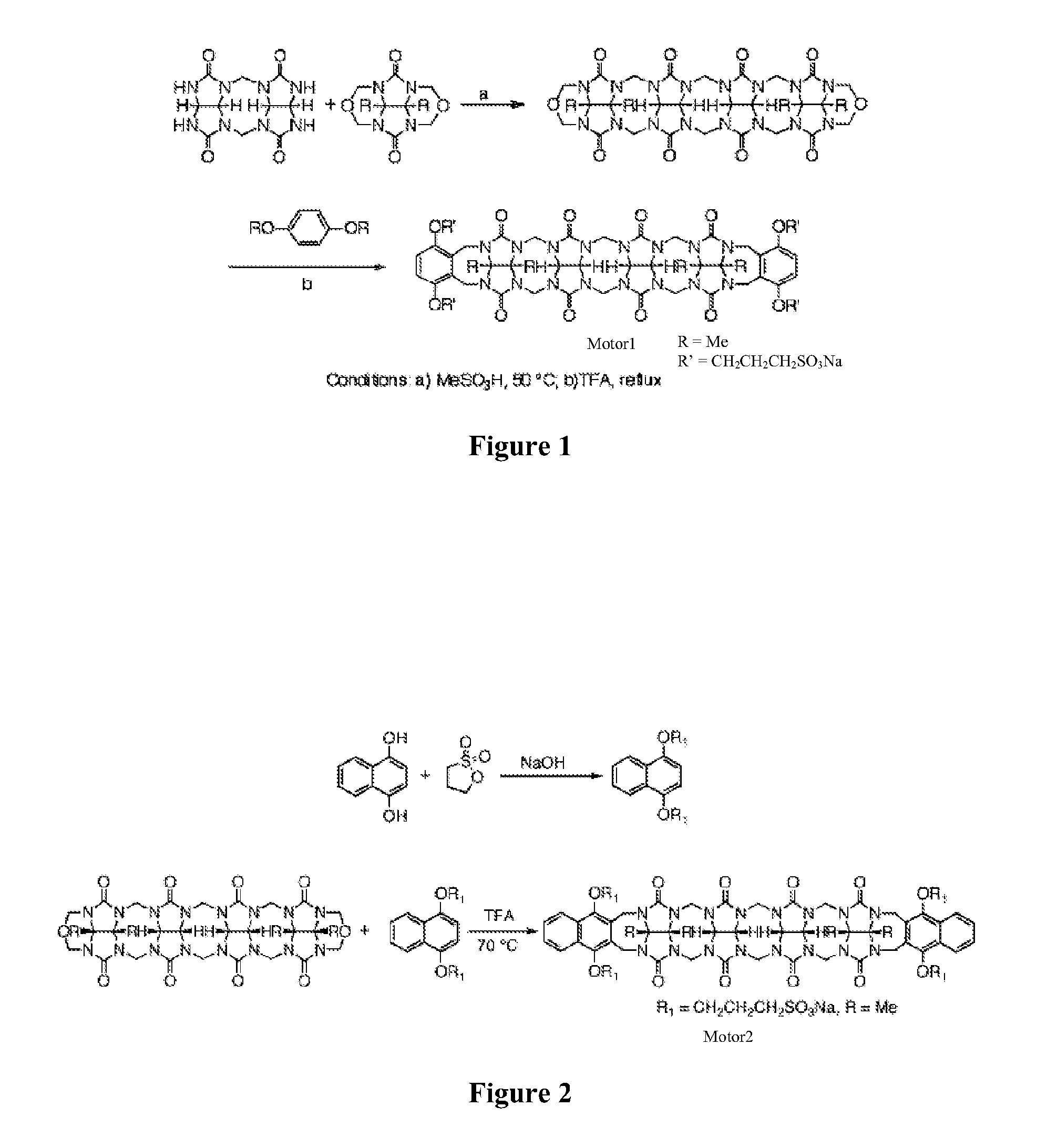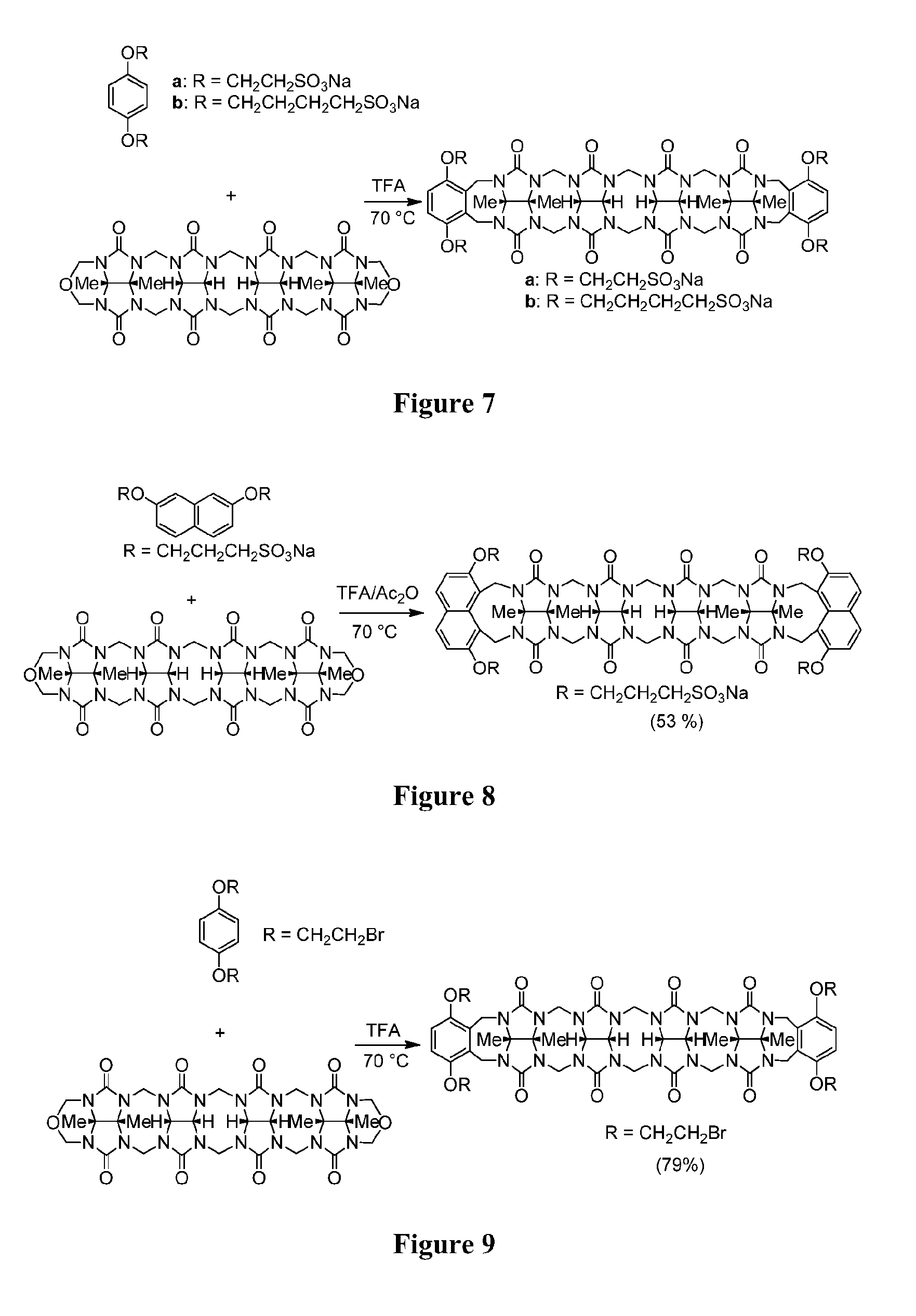Reversal of drug-induced neuromuscular block using novel molecular containers
a neuromuscular block and molecular container technology, applied in the direction of biocide, organic chemistry, drug composition, etc., can solve the problems of many side effects of inhibitors, insufficient sedation and analgesia alone to render patients, and inability to fully or partially reduce the effect of the agent(s)
- Summary
- Abstract
- Description
- Claims
- Application Information
AI Technical Summary
Benefits of technology
Problems solved by technology
Method used
Image
Examples
example 1
[0113]General Experimental.
[0114]Starting materials were purchased from commercial suppliers and were used without further purification or were prepared by literature procedures. Melting points were measured on a Meltemp apparatus in open capillary tubes and are uncorrected. IR spectra were recorded on a JASCO FT / IR 4100 spectrometer and are reported in cm−1. NMR spectra were measured on Bruker DRX-400 instrument operating at 400 MHz for 1H and 100 MHz for 13C. Mass spectrometry was performed using a JEOL AccuTOF electrospray instrument (ESI). UV-Vis absorbance was measured on Varian Cary 100 UV spectrophotometer.
[0115]Synthetic Procedures and Characterization. Glycoluril Dimer.
[0116]A mixture of glycoluril (500 g, 3.51 mol) and paraformaldehyde (105 g, 3.51 mol) in HCl (8 M, 70 mL) was heated at 50° C. for 48 h. The reaction mixture was cooled and filtered. The solid was washed with water (500 mL) and then recrystallized with TFA (1.5 L) to yield Glycoluril Dimer as a white solid (...
example 2
[0131]Propargyl Host (FIG. 3).
[0132]Methyl tetramer (1.70 g, 2.18 mol) in TFA (5 mL), 1,4-bis(prop-2-yn-1-yloxy)benzene (1.62 g, 8.71 mmol) was added. The solution was heated at 50° C. for 4 h. The solvent was removed with rotary evaporation. The crude product was further dried on high vacuum and then washed with water (50 mL). The solid was washed with acetone (50 mL×2) and filtered. Then this solid was dissolved in concentrated HCl (50 mL) and then precipitated by adding water (100 mL) to yield a white solid (1.1 g, 1.0 mmol, 45%). M.P.>260° C. (decomposed). IR (ATR, cm−1): 2939 w, 1721 m, 1463 m, 1380 m, 1314 w, 1231 m, 1211 m, 1186 m, 1090 m, 941 s, 848 w, 796 m, 758 m, 616 m. 1H NMR (400 MHz, D2O): 6.92 (s, 4H), 5.54 (d, J=14.9, 2H), 5.45 (d, J=15.0, 4H), 5.34 (d, J=9.0, 2H), 5.23 (d, J=9.0, 2H), 5.15 (d, J=15.8, 4H), 4.79 (d, J=15.0, 4H), 4.72 (d, J=15.0, 4H), 4.10 (d, J=15.8, 4H), 4.03 (d, J=15.0, 4H), 4.03 (d, J=14.9, 2H), 3.52 (s, 4H), 1.65 (s, 6H), 1.61 (s, 6H). 13C NMR (1...
example 3
[0169]
TABLE 1Binding constants of Motor1 towards guests:GuestKavecuronium5.8 ± 0.9 × 106pancuronium4.5 ± 0.1 × 105atracurium1.4 ± 0.1 × 106tubocurarine4.7 ± 0.2 × 105gallamine6.2 ± 0.5 × 106acetylcholine2.4 ± 0.1 × 104
TABLE 2Compounds used and their binding affinities towards Motor2.Compound NameKa (M−1) with Motor2Rhodamine 6G2.3 ± 0.2 × 108Cyclohexanediamine2.1 ± 0.2 × 108Proflavin7.8 ± 0.8 × 108Bacuronium3.4 ± 0.6 × 109Vecuronium1.6 ± 0.2 × 109Pancuronium5.3 ± 0.5 × 108Atracurium besilate1.0 ± 0.1 × 109Gallamine3.2 ± 0.4 × 108Turbocurium2.2 ± 0.3 × 109Acetylcholine1.8 ± 0.2 × 108
PUM
| Property | Measurement | Unit |
|---|---|---|
| pH | aaaaa | aaaaa |
| reaction time | aaaaa | aaaaa |
| temperatures | aaaaa | aaaaa |
Abstract
Description
Claims
Application Information
 Login to View More
Login to View More - R&D
- Intellectual Property
- Life Sciences
- Materials
- Tech Scout
- Unparalleled Data Quality
- Higher Quality Content
- 60% Fewer Hallucinations
Browse by: Latest US Patents, China's latest patents, Technical Efficacy Thesaurus, Application Domain, Technology Topic, Popular Technical Reports.
© 2025 PatSnap. All rights reserved.Legal|Privacy policy|Modern Slavery Act Transparency Statement|Sitemap|About US| Contact US: help@patsnap.com



